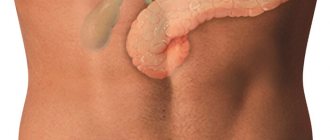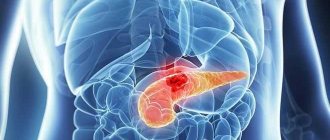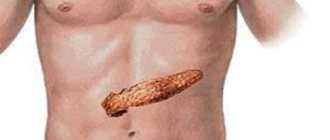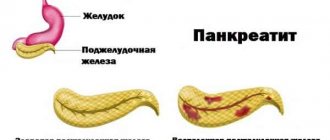What it is?
Palpation for the pancreas is a diagnostic method that involves palpating the patient’s body in order to determine the condition of the organ.
Despite its apparent simplicity, the method is quite complex, since the pancreas is located quite deep, in addition, strong muscle resistance interferes with diagnosis.
According to statistics, in a healthy state the pancreas is palpable in no more than 1% of male patients and 4% of female patients. In women, this is due to thinning of the abdominal wall after childbirth. In most people who receive proper nutrition and do not have significant health problems, it is almost impossible to palpate the gland.
Important. However, during inflammatory processes and pathologies, the pancreas increases in size, which greatly simplifies the process.
The gland is best palpated at the initial stage of the disease and during the period of exacerbation. However, even with chronic pancreatitis, a specialist can palpate it in almost half of the patients.
Methodology
A finger examination of the pancreas is performed with the patient lying on his back. The procedure is carried out on an empty stomach, or after cleansing procedures.
To determine pancreatic diseases by palpation, two different diagnostic methods can be used. One of them is the Obraztsov-Strazhescu method.
This technique was introduced into medical practice back in the 19th century. The procedure for carrying it out is as follows:
- Determination of the study area.
- Determination of organs located next to the gland being studied.
- Palpation of the organ. To do this, the fingers are placed slightly above the lower part of the stomach. When the patient inhales, the diagnostician forms a special fold. And as you exhale, the doctor’s fingers deepen, after which they slide without interruption to the posterior abdominal wall. If at this moment the patient experiences pain, this indicates the development of an inflammatory process. The absence of discomfort when immersing the fingers, on the contrary, indicates satisfactory health.
Important. In case of inflammation, the pancreas will be palpable as a small cylinder 1-2 cm thick.
All finger movements during the examination are carried out along the organ along horizontal lines, which are located 3-4 cm above the greatest curvature of the stomach.
We also recommend viewing: What is pancreatic lipomatosis and how to deal with it?
The second method of examination by palpating the organ is Grotte palpation. This technique involves the use of targeted painful techniques. During diagnosis, the patient should lie on his right side with his legs bent and his right arm behind his back.
As the patient exhales, the doctor inserts his fingers, determines the intersection of the pancreas with the spine and acts on certain points. Based on the patient’s reaction to manipulation, the specialist is able to determine the presence of pathologies.
Using this study, not only the presence of inflammation is determined, but also its localization, which is why it is most common in diagnosing pancreatic diseases.
Methods for palpation of the pancreas
Palpation of the pancreas is usually carried out using some special techniques.
There are two main methods for carrying out the procedure.
The technique is a certain algorithm of actions that the doctor adheres to.
The algorithm of actions depends on the palpation method and is as follows:
- Palpation according to Grotto involves examination using pinpoint painful techniques. During the examination, the patient should be in a lying position on the right side. The lower limbs should be bent. The right hand is behind the back. The specialist palpates the left half of the abdomen and goes to the rectus muscle. The patient exhaled, the fingers should sink towards the wall of the abdominal cavity. If pain is felt on the right side of the navel, this means that the head has succumbed to the lesion. Pain in the epistragal region means that the body is affected. A tail lesion is diagnosed if pain is detected under the left rib. Pain that covers the entire lower back is observed if the entire pancreas is inflamed. This method is used most often in practice.
- The Obraztsov-Strazhescu method was introduced into medicine back in the 19th century. Determines the position of the organ, as well as how elastic the pancreas, spleen, and liver are. The fingers should be placed a few centimeters above the navel. A fold of skin is made, the patient inhales using the abdomen. After the first inhalation, you need to plunge your fingers deep; on the second, your fingers slide downwards. In this way the head can be determined. If it is in a healthy state, then palpation is not observed. When inflamed, it can be clearly felt. Increased elasticity of the organ is observed with pancreatitis.
There are special points of the pancreas for proper palpation of the organ. If the head of the pancreas is damaged, the pain will occur at the Desjardins point. To determine it figuratively, you need to draw a straight line from the navel to the right armpit. There will be a point located six centimeters towards the depression from the navel.
If inflammation affects the head of the organ, pain penetrates the Shoffar point. It is located on the right side of the midline of the abdomen, located five centimeters above the navel. The location of the Mayo-Robson point determines the degree of damage to the tail of the pancreas.
It can be determined by the line connecting the midline of the ribs with the navel. The line is divided into three parts. The border of the middle and outer segments will be this point.
Structure of the pancreas and area of study
The pancreas is located under the pit of the left hypochondrium, and depending on the sources of blood supply, it is divided into three sections: the head, the body and the tail. Most often, the head of the pancreas is located slightly higher than the other parts. The projection of the organ shows it from different sides.
To determine the nature of the disease, you need to know the areas and how to identify them during research:
- The head is the area that is supplied with blood by the branches of the mesenteric artery. On palpation, the pancreas is felt as a soft, elastic and smooth formation. The size of the head reaches up to 3 centimeters.
- Body. The main source of blood for this part of the organ is the splenic artery. It can be felt 3-6 cm above the umbilical line and is located horizontally. Upon palpation, it does not move and is felt as a smooth cylindrical surface without protrusions and bumps.
- Tail. Its blood supply is provided by the splenic or gastroepiploic arteries. This part of the organ is hidden in the left hypochondrium and cannot be felt.
Based on changes in the structure of one or another part of the pancreas, an experienced specialist can identify the pathology of the organ and determine its possible causes.
Palpation by points
To carry out Grotto palpation, certain projection points of the pancreas are used, located on the anterior abdominal wall. The body’s reaction when exposed to each of them makes it possible to determine in which area of the pancreas inflammation develops, and even the nature of the pathology.
We also recommend viewing: Causes and treatment of pancreatic atrophy
During the study, doctors influence the following:
- Desjardins. It is located 4-6 cm from the umbilical cavity, along a conventional line that connects the navel to the right armpit (to the right and slightly up from the navel). The patient’s painful reaction when exposed to this point indicates damage to the head of the organ and the development of acute pancreatitis.
- Mayo-Robson. It is localized on the line connecting the navel with the middle of the rib arch. To find a point, the conditional line is divided into three parts. The projection will be located between the middle and outer segment (upper left square of the abdomen). Exposure to this area makes it possible to determine lesions in the tail.
- Kacha. Located on the outside of the terminal part of the rectus abdominis muscle (several cm above the umbilical cavity). Pain during palpation indicates pathology in the body and tail of the pancreas.
- Male Guy - located just below the rib, on the left in the line of the rectus abdominis muscle. With its help, pancreatitis can be detected in the chronic stage.
- Hubergritsa - located on the left symmetrically to the Desjardins point and indicates problems with the body of the gland.
In addition to specific points, palpating the pancreas, the doctor can act on the following areas:
- Shoffara - on the right side between the navel and the armpit.
- Janovera - located on a horizontal line passing through the navel and 3-5 cm to the left.
- Gubergritsa-Skulsky - similar to the Shoffar zone, only on the opposite side.
In addition, the study may reveal Voskresensky's symptom, when the pulsation of the abdominal aorta is not detected in the projection of the organ being examined.
Palpation of the pancreas
Palpation is carried out in a supine position after cleansing the intestines with an enema. Sometimes gastric lavage is prescribed. If everything is fine with the organ, then the skin of the epigastrium is painless, there is no tension. The thickness of the subcutaneous fat layer on the left and right should be the same.
With superficial palpation, attention is paid to the sensitivity of the skin.
Painful sensations can occur during acute pancreatitis or during an exacerbation of the chronic form. Tension reflects the severity and extent of inflammation. But at the beginning of the disease this sign may be absent.
Palpation according to Grotto is based on painful techniques. To carry out the procedure, the patient lies on his right side, but his legs are bent. The right hand is brought back. Palpation passes to the left side of the abdomen from the rectus muscle. As you inhale, your fingers sink to the back wall.
The main points are investigated:
- Desjardins point. It is located at the intersection of conventional lines that connect the armpit on the right and the navel. If there is pain, we can talk about damage to the head of the pancreas.
- Mayo-Robson point. It is located on the lower segment of the line from the navel to the left armpit. Severe pain at the point indicates inflammation of the tail.
- Shoffar's point. She also talks about problems with the head. It is found on the right side of the middle of the abdomen along the bisector of the umbilical angle.
The Grotto method is used more often. The classic method allows you to identify the problem only in the presence of tumor problems, as well as in very flabby abdominal wall. In this case, the gland is palpated as a stationary flat cord located in the horizontal direction.
When it is possible to feel a normal gland, a feeling is created of rolling the fingertips over a painless roller with a diameter of about 1.5-2 cm. The organ should be motionless, not purring, and not changing shape in response to the measures taken. This distinguishes it from nearby organs.
The examination begins with healthy tissue. The tail of the gland is palpated with the right palm. It is placed at the outer edge of the abdomen (left rectus muscle). This is done so that the fingertips are at the level of the left costal arch.
For convenience, doctors use the bimanual palpation method. In this case, the left palm is placed on the right side under the patient’s back. During the examination, the doctor, as the patient exhales, moves the posterior abdominal wall in the direction of the palpating hand.
Rules for palpation in children
Examination of the pancreas by palpation of the organ can be carried out in both adults and children. In the latter, palpation is carried out when there is a noticeable enlargement and thickening of the pancreas. At the same time, the basic rule of conducting the examination remains unchanged - diagnosis is carried out only on an empty stomach.
During the procedure, the doctor first palpates the stomach and transverse colon. This is done in order to correctly navigate and not mistake any other organ for the pancreas.
We also recommend viewing: How is it recommended to treat the pancreas during an exacerbation?
Having determined the exact location of the pancreas, the doctor places his fingers horizontally to the child’s body and parallel to the longitudinal axis of the organ to be examined. In this case, the fingers are located approximately 2 cm above the curvature in the stomach area.
When a small patient inhales, the doctor creates a “skin fold” and gradually penetrates deeper with his fingers until he touches the back wall of the abdominal cavity. Having felt the desired organ, the diagnostician moves his fingers in different directions to fully examine it.
The norm for a child is considered to be a pancreatic diameter of no more than 2 cm. It should be positioned horizontally. In this case, the gland should be soft, motionless with unclear contours. During palpation, the baby should not feel discomfort or pain.
Establishing diagnosis
Qualified palpation of the pancreas helps the doctor get an objective idea of the condition of the organ and the pathologies developing in it.
Thus, the development of pancreatitis in the acute or chronic stage is indicated by a change in the density of the pancreas. It becomes more elastic, springy, or resembles thick dough in its consistency.
The diagnosis is confirmed by pain that occurs on palpation and radiates to the back. The pain reaches its greatest intensity when the patient bends forward. The pain subsides if the patient lies on his left side.
Also, by palpation, the doctor can diagnose the development of neoplasms in the pancreas (cysts and tumors). In this case, seals and tubercles are felt on its surface. Just as with inflammation, when palpating tumors, the patient experiences pain in certain parts of the back or abdomen.
Too strong pulsation of the aorta may also indicate the development of a tumor.
Examination of the pancreas
The first thing you will have to pay attention to when examining the pancreas is how much it is inflamed and what form of the disease is - acute or has already become chronic.
At first, the disease can be practically asymptomatic, and then complications may arise, the most insidious of which are considered to be purulent inflammation, necrosis of the pancreas, and cancerous formations on the organ.
It is very important to pay attention to how the patient behaves while his pancreas is being palpated, to take a closer look at his movements, and not just listen to verbal comments. In acute pancreatitis with pronounced pain, the patient will lie strictly on his back.
When it comes to pancreatic cancer, the patient often assumes a sitting position with his legs hanging off the bed. As a rule, he slouches heavily and presses his hands to the abdominal cavity, as this position helps relieve pain.
It is worth carefully monitoring the dynamics of the patient’s weight. If he has lost a lot of it, then this is characteristic of either a severe form of pancreatitis or pancreatic cancer, and we are not only talking about the loss of excess fat, with such diseases muscle mass is also burned.
If you suspect pancreatitis, you should pay attention to the skin, which in most cases has a yellowish or simply pale tint. In addition, a professional doctor will be able to determine by skin tone what form of disease the patient is suffering from. Just pale skin indicates that this patient has acute inflammation of the pancreas. Jaundice indicates that a tumor is developing in the head of the pancreas, or that compression of the bile ducts has occurred.










